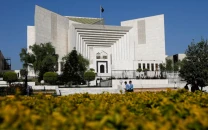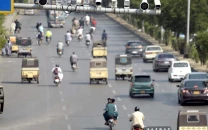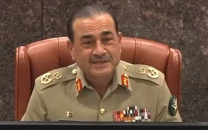Scattered showers hit Karachi amid ongoing power outages
Gulshan-e-Hadeed recorded highest rainfall at 18mm; monsoon system expected to weaken by Friday
1725429132-0/Untitled-design-(12)1725429132-0-640x480.webp)
Karachi witnessed another spell of rain on Thursday — lighter and more scattered than in previous days — with power outages lingering across several neighbourhoods, even as drainage efforts restored access to key roads, markets, and underpasses.
The city experienced scattered rainfall as the prevailing monsoon system continued to influence weather patterns. While some areas saw clear skies by afternoon, others remained under a blanket of clouds.
Showers began late in the day, first hitting the suburbs of Gulshan-e-Maymar, Ahsanabad, and Gulshan-e-Hadeed before sweeping across Orangi Town, Gulshan-e-Iqbal, North Karachi, NIPA Chowrangi, University Road, DHA, Clifton, Saddar, Kala Pul, Akhtar Colony, and Qayyumabad. Light rain, drizzles, and sporadic showers were reported across various localities.
Read: Karachi reels from torrential rains
According to the Pakistan Meteorological Department (PMD), Gulshan-e-Hadeed received the highest recorded rainfall on Thursday with 18mm. Surjani and North Karachi recorded 7mm each, Masroor Base saw 4mm, Gulshan-e-Maymar received 3.4mm, the Old Airport area got 2.6mm, while Saadi Town and University Road recorded 1.1mm and 1mm respectively.
Commandos of ‘Urban Flooding Rescue Unit assisting the stranded citizens at Shahrah-e-Faisal.#SSU | #Commandos | #Rescue | #Rain | #Monsoon | #karachi | #SindhPolice | #KarachiRain pic.twitter.com/LTbtlOym8P
— SSU Sindh Police (@ssusindhpolice) August 21, 2025
Over a three-day period, Surjani Town recorded the highest cumulative rainfall at 219mm. It was followed by Keamari with 204mm, Saadi Town with 198.8mm, Orangi Town with 195.7mm, and Nazimabad with 194.6mm. The Old Airport area saw 187mm, Jinnah Terminal 184.8mm, University Road 174.6mm, and Korangi 178.9mm. Other notable figures included Faisal Base at 177mm, North Karachi at 158mm, Gulshan-e-Maymar at 145.6mm, and Masroor Base at 140mm.
Another system on the horizon
Chief Meteorologist Karachi Amir Haider Laghari said the monsoon system is expected to weaken by Friday, reducing the likelihood of further heavy rainfall. However, the city is likely to remain overcast on Saturday, with partly cloudy conditions expected on Sunday and Monday.
He added that temperatures are expected to remain relatively mild in the coming days due to residual effects of the current weather system.
Meanwhile, PMD Karachi spokesperson Anjum Nazir Zaigham warned that a new monsoon system could develop shortly after the current one dissipates. This upcoming system may bring rain to Tharparkar, Mithi, and Umerkot from August 26 and could begin affecting Karachi by August 27.
Read more: Record rainfall wake-up call on climate change: mayor
However, he noted that since the system is still distant, it is too early to accurately forecast the intensity or impact it might have on the city. A clearer picture is expected to emerge in the next three to four days.
In its latest advisory, the Met Office predicted rain accompanied by wind and thunderstorms in the upper and central regions of the country between August 23 and 27. In Sindh, heavy rainfall is expected between August 23 and 26 in Mithi, Tharparkar, Umerkot, and Mirpurkhas.
Drainage operations progressing across city
The Karachi administration has issued an update on ongoing drainage efforts following days of monsoon rainfall, confirming that rainwater has been cleared from most major markets, underpasses, and causeways across the city.
Markets including Jodia Bazaar, Allah Wali Market, and Jama Cloth Market have been fully drained, allowing commercial activity to gradually resume.
According to officials, water drainage has been completed at more than four key underpasses, which have now been reopened to traffic. These include Nazimabad, Tariq Road, Sohrab Goth, and Golimar underpasses. Additionally, the NIPA intersection has also been cleared and is now open for traffic.
Commissioner Karachi Syed Hassan Naqvi noted that all departments are working in close coordination. “Deputy Commissioners are actively managing drainage and traffic flow, while Assistant Commissioners are in the field ensuring operations run smoothly,” he said.
The Civic Center to Mazar-e-Quaid route via Old Sabzi Mandi has also been reopened, though traffic congestion is reported on the inbound lane due to a sewerage issue. Commuters have been advised to avoid the route where possible.
Shahrah-e-Faisal Road and Jam Sadiq Bridge remain open and unaffected, with traffic flowing normally. Meanwhile, both the Korangi Causeway and EBM Causeway — previously closed due to waterlogging — have now been cleared and reopened.
Drainage work is also progressing rapidly at the Drigh Road underpass, where pumps are actively in operation.
Power outage
Despite intermittent rainfall, prolonged power outages continued to plague Karachi on Thursday, with several localities still without electricity more than 50 hours after supply was first disrupted. Areas including Malir, University Road, and Tipu Sultan Road remained in the dark, prompting frustrated residents to take to the streets in protest.
According to residents, electricity was suspended around 2:30pm on August 19 following heavy showers. By the third day, the continued blackout had also affected water supply, with many neighbourhoods reporting little to no access to stored water.
Residents in North Nazimabad Block A, Gulistan-e-Jauhar Block 9, and Safora Goth Scheme 33 said they had been without power for over 36 hours, with the outage beginning during the first spell of rain on Monday afternoon.
Protesters staged sit-ins outside K-Electric offices, chanting slogans and criticising the utility’s lack of response. Demonstrators claimed power had not been restored in Model Colony, Bostan Society, Amirabad and adjacent areas, despite repeated complaints.
In Malir, residents blocked roads near Mehran Depot and Liaquat Market, causing major traffic jams along Jinnah Avenue, Model Colony and surrounding arteries. Further demonstrations were reported outside K-Electric’s Tipu Sultan office and along University Road near the NIPA intersection.
Karachi Mayor Barrister Murtaza Wahab reached District Central, inspecting various locations including Nagin Chowrangi, Two-Minute Chowrangi, Surjani, Sakhi Hassan, KDA Chowrangi, Hyderi and other areas.
The mayor said that Karachi Metropolitan Corporation (KMC) teams worked day and night to clear all affected areas, which he inspected. He added that timely disposal efforts and swift performance of the staff ensured drainage of rainwater.
“The process of draining rainwater from across the city is being carried out at the earliest,” Wahab said.
During his visit, the mayor also listened to public complaints and issued immediate directives for their resolution.
Rain-related deaths
At least 18 people, including women and children, have died in rain-related incidents across Karachi since Tuesday. The deaths were caused by wall collapses, electrocution and drowning.
On Thursday, two brothers, Siraj and Murad, were electrocuted by an underground high-tension cable in Shah Faisal Colony. Their father has filed an FIR against K-Electric officials for negligence.
Also read: Two days of relentless rains in Karachi leave at least 16 dead
Rescue officials said two children drowned in drains in Sohrab Goth and Liaquatabad, while bodies of an elderly man and a teenager were recovered from waterlogged areas in New Sabzi Mandi and Gulshan-e-Maymar.
A 50-year-old man, Muhammad Abbas, drowned after falling into an uncovered drain near Guru Mandir.
In Gulistan-e-Jauhar, the collapse of a private school’s wall on roadside huts killed two women and two children; a three-year-old girl later died of her injuries, raising the toll to five. An eight-year-old boy was also killed in a wall collapse in Orangi Town.
Separately, at least five people, including young men and an elderly person, died of electrocution in DHA, Shahrah e Faisal, North Karachi and Gizri Bridge.
Climate change
Climate change expert Fatima Yamin stressed that while mitigation and adaptation are important, they are often overhyped, and greater investment is needed in preparedness and prevention.
She said these measures are crucial not only to prepare communities for future challenges but also to prevent severe damage to infrastructure, particularly homes and schools.
Yamin noted that Pakistan does not offer disaster insurance or immediate compensation, forcing affected people to rebuild their livelihoods from scratch.
She added that climate impacts should not be dismissed as natural phenomena, as unchecked mining, deforestation and industrialisation are worsening the crisis.
Yamin further said Pakistan could strengthen its position at COP by ensuring transparency in the use of climate finance and the reconstruction funds received after the 2022 floods.
She pointed out that the government appears to be investing more in humanitarian response than in prevention and preparedness, while international partners are providing adaptation and mitigation funding.
Pakistan, she emphasised, must also demonstrate how much of its domestic revenue is allocated to climate action, rather than relying solely on loans and grants.
Flight operations
Adverse weather has caused significant disruption to flight operations at Karachi airport, with at least 12 flights delayed so far.
Both domestic and international services have been affected.
According to airport officials, Iraq Airways’ flight to Najaf departed an hour late at 6am, while Airblue’s Karachi–Jeddah flight 170 left seven hours behind schedule at 10am.
Qatar Airways flight 605 to Doha, Flydubai flight 332 to Dubai, and Etihad Airways flight 297 to Abu Dhabi each departed an hour late.
On the domestic side, PIA’s Karachi–Skardu flight 455 and Karachi–Islamabad flight 300 faced delays of an hour and 20 minutes, respectively, while Serene Air’s Karachi–Lahore flight 520 was delayed by 30 minutes.
AirSial’s Karachi–Islamabad flight 121, scheduled for 7am, had not departed by the time of reporting, and PIA’s Karachi–Lahore flight 302, scheduled for 8am, was also still grounded.
PIA’s Karachi–Gwadar service (503) was cancelled altogether, while Fly Adeal’s Karachi–Riyadh flight 3662 was delayed by half an hour.
Saudi Airlines’ Karachi–Jeddah flight 701 finally departed at 10:10am, an hour late.
Government Official
Sindh Senior Minister Sharjeel Inam Memon, offering prayers for journalist Khawar Hussain before his press conference, said climate change was a global challenge and Pakistan, despite its minimal role in emissions, was suffering its impacts.
He noted that since June, heavy rains had claimed 447 lives in Khyber Pakhtunkhwa, 165 in Punjab, 40 in Sindh, 23 in Balochistan and 8 in Islamabad. Continuous downpours, he said, caused urban flooding in Karachi, where Manghopir recorded 246mm of rain. Most city deaths were from electrocution.
Memon said advance drain cleaning was carried out, heavy machinery was deployed, and the chief minister monitored the situation. He apologised for the citizens’ difficulties but said water drainage was largely managed.
He accused some media houses of running campaigns against the PPP, while Dawn acknowledged improved drainage. Criticising opponents, he said those now attacking the government had seen far more deaths during their tenures.
A public holiday was declared, with people advised to stay indoors. Memon stressed the Sindh government remained on the streets throughout the crisis and urged that such issues should not be politicised.
Sindh Minister for Local Government, Saeed Ghani, visited various areas of Karachi on Thursday.
He was accompanied by Sindh Chief Minister’s Special Assistant Usman Hingoro, Deputy Commissioner South Javed Nabi Khoso, Lyari Town Chairman Nasir Karim, Municipal Commissioner Hammad N D Khan, PPP District South President Jawaid Nagori, as well as chairmen of different union councils of Lyari and other officials.
The provincial minister inspected rainwater drainage work in low-lying areas and streets during his visit to II Chundrigar Road, Lighthouse, M.A. Jinnah Road, Bolton Market, Merewether Tower, Kharadar, Nayaabad, Khadda Market and other parts of Lyari.
“After clearing all major thoroughfares of rainwater, efforts are now being expedited to drain water from adjoining streets and neighbourhoods,” Ghani said. He added that drainage of rainwater from all main roads in Karachi had been completed.
“At one or two sites, drainage work at underpasses is under way, which will also be completed by this evening and the underpasses will be reopened,” he stated.
The minister directed the deputy commissioner and other relevant officials to install small and large pumps in areas where complaints of water stagnation are being received.
He said the Water Board had also been instructed to immediately resolve sewerage issues in affected areas.
During his visit to the Lyari pumping station, Ghani contacted the CEO of the Water Corporation regarding a malfunctioning pump and directed that it be replaced without delay.
“At present, all departments under the Sindh government and local bodies are fully active,” the minister said, adding that all elected municipal representatives were also present among the people.
Mayor Barrister Murtaza Wahab on Wednesday described the recent torrential rains in Karachi as a stark reminder of the global climate crisis, urging citizens to recognize the reality of climate change and respond with practical solutions.
Addressing a press conference at Frere Hall, Wahab said cities worldwide-including New York, Dubai, and Mumbai-are facing similar challenges. He cited recent climate-related disasters in Khyber-Pakhtunkhwa, Gilgit-Baltistan, and Azad Kashmir as further evidence of the growing threat.
Karachi witnessed two intense spells of rainfall on Tuesday, with Manghopir recording 235mm and citywide totals exceeding 170mm in just 12 hours.
"Our storm-water drains are designed for only 40mm. When rainfall exceeds that multiple times, disruption is inevitable," Wahab explained.




















COMMENTS
Comments are moderated and generally will be posted if they are on-topic and not abusive.
For more information, please see our Comments FAQ